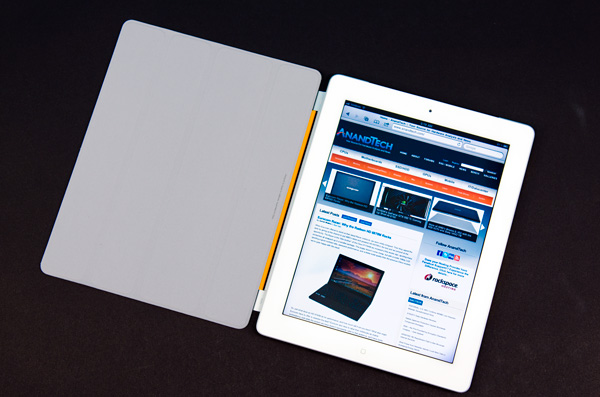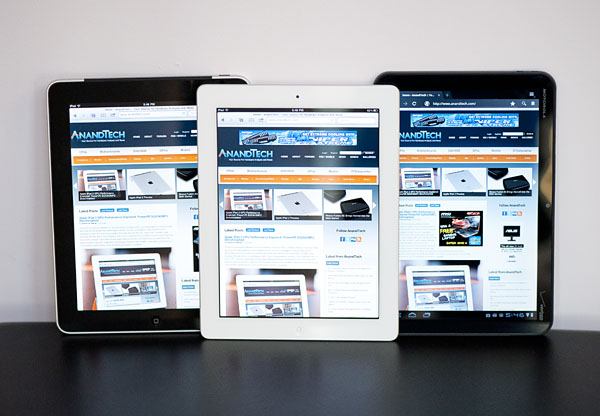The Apple iPad 2 Review
by Brian Klug, Anand Lal Shimpi & Vivek Gowri on March 19, 2011 8:01 PM ESTFinal Words
If you fell in love with the original iPad, the iPad 2 is a significant upgrade. You get much faster hardware, a much more ergonomic device and the ability to FaceTime with your friends. If it weren't for the fact that the iPad 3 is likely 12 months away with another set of similarly impressive upgrades I'd recommend all iPad users upgrade to the 2nd generation model.
I find that with Apple products you have to pick an upgrade cadence and firmly stick to it. In the Mac world it's difficult but not too hard to stick to. Upgrading yearly never makes financial sense so usually putting yourself on a 2 - 3 year cycle for the biggest upgraders usually works. Apple hardware tends to hold its value surprising well so as long as you do a good job of reselling your old stuff, this cadence can work well if you absolutely must have the latest and greatest.
The iOS platforms are a bit more difficult to be patient with. As you can see by the SoC upgrades Apple has thrown into the iPad 2, for the next couple of years you should expect Apple to be upgrading at a rate faster than Moore's Law. Eventually this will level off but for the iPad 2, iPad 3 and probably even the iPad 4 we'll see this sort of aggressive ramp in hardware capabilities. You really have to treat the iPad like a smartphone - it's going to be made significantly less desirable in about 12 months so plan your purchasing accordingly.
Cautious purchasing brings me to my biggest complaint about the iPad 2 - its pricing. Motorola gets a bad rap for pricing the first Xoom at $799, but there's only one iPad 2 that sells at $499. Buy a case, pick one of the higher capacity models, add 3G and you're quickly paying a lot more for the iPad 2 than you would a mainstream PC. Granted Apple doesn't make as much off of the iPad as it does other members of its product lineup, but I still feel the price is too much for a device that can only augment your existing computing devices.
I do wish Apple was able to increase display resolution on the iPad 2, although I suspect that combined with the SoC improvements that may have been a little too much for this generation. It's clear that a higher resolution panel is coming as Apple finally has an OS that properly handles DPI scaling. The real question is when, and is that time soon enough that you can hold off buying an iPad until then?
There's no better place to say this so I'll just put it out there: Apple's commitment to increasing performance deserves serious recognition. Whether or not you like the company, Apple outfitted the iPad 2 with a pair of ARM Cortex A9s and a GPU significantly faster than anything else on the market. Look around and you won't see many apps that can really stress the PowerVR SGX 543MP2 that Apple put in the A5. Make no mistake, this is about building a big install base of high performance mobile devices. Apple is eager to win the hearts of game developers with the A5. Gaming will be an important part of the tablet's evolution and Apple clearly understands that. What happens when your tablet is fast enough to run Halo? Performance matters here, maybe not as much today, but when the entire install base has PowerVR SGX 543MP2s at the bare minimum things will get really interesting.
Apple's fat trimming really improved the iPad 2's ergonomics, and the smart covers only helped improve things. While I wouldn't consider porting the original iPad around due to its limited usefulness in my workflow, the iPad 2 is thin and light enough where I'm less bothered by it. Ultimately I feel like tablets (iPad or not) have to be even thinner and even more ergonomic to really come into their own. The good news is that Apple hasn't done anything too exotic in slimming down the original iPad. I'd expect the second generation of Android tablets to be similarly thin/light.
And that brings us to the controversy, the Honeycomb comparison. The Xoom is the only real competition shipping for the iPad 2 today, but within 60 days we'll likely have competitors from ASUS and Samsung on the market as well. Honeycomb has some serious advantages in the feature department. Multitasking is better under Android 3.0, as are notifications and as of yesterday there's finally Flash support. Apple still provides a smoother UI than Honeycomb, however this time around I'm wondering how much of that might be due to the GPU horsepower behind Tegra 2. While Tegra 2 does well on a lower resolution screen, I feel like it is underpowered to deal with the Xoom's 1280 x 800 display.
Hardware-wise Apple has an ergonomics advantage over the Xoom. While I like holding the Xoom more than the original iPad, I prefer the iPad 2's feel to the Xoom. The Xoom has the edge in camera quality and display resolution, while the iPad 2 has a better looking display and a faster GPU. I still fundamentally believe that web browsing and email are the killer apps for tablets and as such I don't put too much weight in Apple's iPad app advantage. Long term I believe that the most important apps will be available on both platforms, so unless there's an app that you want today that's an iOS exclusive I wouldn't lose sleep over it.
So if you're actually torn between the iPad 2 and the Xoom my best advice is to wait. Apple needs to update iOS in a major way and Honeycomb needs a hardware update. Whichever gets it right first should get your money.
If you don't fall into the borderline camp then the decision is pretty simple. If you need a tablet that runs iOS today, the iPad 2 is great. If you're not sure, you should wait. Tablets are still a couple of generations from being really amazing. Everything between now and then are just steps along the way.














189 Comments
View All Comments
claytontullos - Saturday, March 19, 2011 - link
http://technabob.com/blog/2011/03/18/ipad-2-refrig... kind of fun?vol7ron - Saturday, March 19, 2011 - link
This just goes back to what I've said since the iPad was introduced. It'll be the +1 device that's best for laying around your house. This goes into my review as why it needs to hit the $200-250 price point.Sure it's a nice e-Reader and can entertain with some games and even allow for some production work, but it is still clunky and uncomfortable and to be efficient and productive you need the additional hardware, which are going to bring you in a nice laptop range anyhow.
The 3GS is hitting the $50-100 price point w/ a 2 year contract, which I suggested a year ago. Personally, I still think that should be the price w/o the contract (to be available after-market for gifts/presents), but as long it's available at that point, that's where it needs to be.
I still think the iPad needs to drop to that $200-250 point. It's the coffee table device, which people should consider having 2-3 spread-out in the home [ maybe one in the bathroom ;) ] - if only they could also self-sync wirelessly. I'm not too sure who buys the base model, but the specs alone would keep me from considering it and when you look at the higher spec'd models, it's not as justified when looking at laptops, or other eReaders.
solipsism - Sunday, March 20, 2011 - link
$200 to $250 for a newly released 10” Tablet with an IPS panel? WTF are you smoking? How can you have such an odd mental disconnect between writing that and then writing "The 3GS is hitting the $50-100 price point w/ a 2 year contract”? What part of 2-year contract aren’t you understanding? Do you not realize the carrier is paying Apple more than $200-250 for that 3GS, and you are paying the carrier a lot more than that over 2 years?Pray tell, how would this device be $200-250 when the competition with a 2 decade head start still hasn’t been able to compete on price?
synaesthetic - Sunday, March 20, 2011 - link
I don't get how they sell so many when they're so useless and clunky... and cost so much.Lot of hipsters I guess.
michael2k - Sunday, March 20, 2011 - link
The weight, battery life, and cost (altogether) are unparalleled in the computing world.Smartphones with similar performance characteristics have far smaller screens and lower battery life.
PCs with similar battery life cost far more and weigh far more.
PCs with similar weight (and still double at that) cost far more and have only fraction of the battery life.
PCs with similar cost weigh far more and have drastically lower battery life.
Meaker10 - Sunday, March 20, 2011 - link
A dual core sandy bridge 13" device is going to be far more useful for work and far more powerful.michael2k - Sunday, March 20, 2011 - link
Who said anything about work? For things like reading Anandtech it would be far heavier, bulkier, and with less battery life.bigboxes - Sunday, March 20, 2011 - link
Just admit that it's a toy. The authors laid it out for you on how they prefer to use other devices instead of the iPad. It too bulky for portability and underpowered for any productivity tasks.So, you're telling me (and everyone else here) that you paid $500+ just to surf AnandTech on your couch? Just wondering.
Stas - Monday, March 21, 2011 - link
That's exactly why it cannot cost this much to be a reasonable buy. No, the following purchases are not reasonable: fa- sheep base, soccer moms that buy the latest gadget with most hype for their kids/husbands not even knowing wtf it does, or PR boost in form of including, again, the most hyped device with cars, hotel rooms, air travel, etc (3 categories right there probably account for 90% of all sales). I mean people that understand exactly what the device is, what it's not, and have a clear idea of how they are going to use it. And it doesn't matter how much it costs to make it, how advanced the hardware is, or how "revolutionary" the design is. Given the limited usability of a slim, touchscreen device, I think asking $600+ for one is ballsy.MScrip - Monday, March 21, 2011 - link
-- "Given the limited usability of a slim, touchscreen device, I think asking $600+ for one is ballsy." --That's true about any tablet.
As great as Honeycomb tablets are... they're still not gonna provide a true computing experience.
A $600 laptop will always provide far more functionality than a $600 tablet...
Yet... all these manufacturers are pumping out tablets at an alarming rate.
Apple took the risk and added a new product to their lineup.
If tablets were destined to fail... we wouldn't see Motorola, Samsung and even RIM jumping into the tablet game...